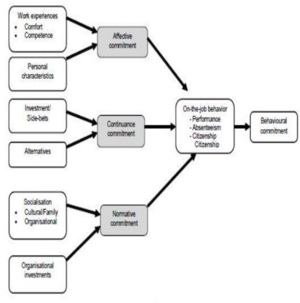Three- Component Model Questionnaire (TCM)
The three-component model of commitment developed by Meyer and Allen (1997) arguably dominates organizational commitment research (Meyer et al., 2002). This model proposes that organizational commitment is experienced by the employee as three simultaneous mindsets encompassing affective, normative, and continuance organizational commitment. Affective Commitment reflects commitment based on emotional ties the employee develops with the organization primarily via positive work experiences. Normative Commitment reflects commitment based on perceived obligation towards the organization, for example rooted in the norms of reciprocity. Continuance Commitment reflects commitment based on the perceived costs, both economic and social, of leaving the organization. This model of commitment has been used by researchers to predict important employee outcomes, including turnover and citizenship behaviors, job performance, absenteeism, and tardiness (Meyer et al., 2002). Meyer and Allen (1997) provide a comprehensive overview of the theoretical lineage of this model.[1]
Meyer and Allen’s Three-Component Model of Organizational Commitment

source: Meyer and Allen(1991)
The questionnaire has been designed to look at an individual in terms of three particular psychological mind-sets which affect an individual’s decision on whether they will stay with the organization (Meyer and Allen, 1997). This questionnaire measures Affective Commitment, Continuance Commitment and Normative Commitment which led to the creation of Meyer and Allen’s (1991) Three Component Model that differentiates between different levels of commitment.
- Affective Commitment (A.C): Affective Commitment is the level of engagement and emotional attachment an employee shows towards their job. This aspect focuses on the employees psychological affinity to a firm; their association with the organization and their desire to remain as an employee of the organization (Meyer and Allen, 1991).
- Continuance Commitment (C.C): Meyer and Allen (1991) suggest that Continuance Commitment is when an employee is aware of the costs involved in leaving the organization. Costs may be seen as a loss of benefits or losing a senior position and the rewards and incentives associated with the position.
- Normative Commitment (N.C): Normative Commitment is where the employee feels obligated to remain committed to the organization. This obligation can be due to an employee feeling that a company has invested time and money in them or they feel an obligation to stay to support their peers (Meyer and Allen, 1991)[2]
See Also
Organization
Organizational Commitment
Organizational Commitment Questionnaire (OCQ)
Organization Design
Organizational Agility
Organizational Capability
Organizational Architecture
Organizational Change
Organizational Change Management (OCM)
Organizational Culture
Organizational DNA
Organization Chart
Organizational Absorption
Organizational Configurations
Organizational Development
References
- ↑ Defining the Three-Component Model Questionnaire (TCM)Stephen Jaros
- ↑ The Levels of Commitment for the Three Component Model Brian Phillips
Further Reading
- TCM Employee Commitment Survey Academic Users Guide The University of Western Ontario
- Reexamination of Factor Structure and Psychometric Properties of the Three-Component Model of Organizational Commitment record/2011-04670-009 Xu, Lihua Bassham, Larry Shawn
- Beyond the Three-Component Model of Organizational Commitment Omar N. Solinger, Woody van Olffen, and Robert A. Roe
